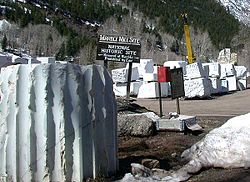Marble
Marble is a metamorphic rock that developed from limestone. Most of the material is calcite (a crystalline form of calcium carbonate, CaCO3) and dolomite. It is often used for sculpture, as a building material, and for many other purposes.
The word 'marble' is also used for other stones that can be polished well and for ball shaped objects used for child games.
'Faux marble' is a wall painting technique that imitates the color patterns of real marble (not to be confused with paper marbling). Marble dust can be combined with cement or synthetic resins to make reconstituted or cultured marble.
Marble has been used in construction for thousands of years. It was widely used by Greek and Roman sculptors and architects. Places named after the stone include Marble Arch, London; the Sea of Marmara; India's Marble Rocks; and the towns of Marble, Minnesota; Marble, Colorado; and Marble Hill, Manhattan, New York. The Elgin Marbles are marble sculptures from the Parthenon that are on display in the British Museum. They were brought to Britain by the Earl of Elgin.
Kinds of marble
Some historically important kinds of marble, named after the locations of their quarries, include:
- Caldia Marble from Rocchette MS, Italy
- Durango Marble from Coyote Quarry, Mexico
- Thassos from Greece
- Paros from Greece
- Rouge de Rance from Rance, Belgium
- Penteli from Greece
- Carrara and Luni from Italy
- Proconnesus from Turkey
- Connemara from Ireland
- Brač from the island of Brač, Croatia
- Black Marble from Kilkenny, Ireland
- Macael from Spain
- Makrana from India
- Boticena and Onyx(Green) from Pakistan
- Danby from Vermont
- Yule from Colorado
- Royal White from China
- Beijing White from China
- Vietnam White from Vietnam
- Llano Pink from Central Texas
White marbles, like Carrara in Italy, Royal White and Beijing White in China, have been prized for sculpture since classical times. This preference has to do with the softness and relative isotropy and homogeneity, and a relative resistance to shattering. Also, the low index of refraction of calcite allows light to penetrate several millimeters into the stone before being scattered out, resulting in the characteristic "waxy" look which gives "life" to marble sculptures of the human body.
Construction marble
In the construction trade, the term "marble" is used for any massive, crystalline calcitic rock (and some non-calcitic rocks) useful as building stone. For example, Tennessee Marble is really a massive, highly fossiliferous gray to pink to maroon Ordovician dolostone, known as the Holston Formation by geologists.
Industrial use of marble
Colorless marbles are a very pure source of calcium carbonate, which is used in a wide variety of industries. Finely ground marble powder is a component in paints, toothpaste, and plastics; calcium carbonate can also be reduced under high heat to calcium oxide (also known as "lime"), which has many applications including being a primary component of most cements.
Description
Marble is dense, with a good range of colors. It can be carved or shaped, and is strong, and many think it beautiful.[1]
Related pages
Other websites
| Wikimedia Commons has media related to Lua error in Module:Commons_link at line 62: attempt to index field 'wikibase' (a nil value).. |
References
- ↑ Learn Science intermediate, by Mike Evans and Linda Ellis




